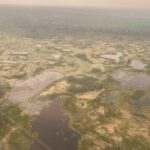Corals, calcifying algae and other marine organisms form their shells or skeletons using aragonite, a soluble type of calcium carbonate mineral. But ocean acidification caused by the oceanic uptake of anthropogenic carbon dioxide is making it harder for these forms of sea life to get the aragonite they need from the water.
Liqing Jiang, an assistant research engineer at the University of Maryland Earth System Science Interdisciplinary Center (ESSIC), compiled decades of global ocean carbon data and found that aragonite saturation, an important indicator of ocean health, is edging toward harmfully low levels off the United States’ West Coast and in other areas.
Jiang was able to determine the regions most vulnerable to aragonite undersaturation, including off the west coasts of the United States, South America and Africa, by looking at data from 50 meters below the surface of the water. He compared aragonite levels from 1989-1998 to those from 1998-2010.
The data show aragonite saturation decreasing around the world. Average saturation dropped by 0.1 from the 1990s to the 2000s – a decrease of 0.4 percent per year in the uppermost 100 meters of the oceans, which are more sensitive because so many organisms live in them.
The drop in aragonite saturation is especially harmful for young shell-builders, Jiang said. And what hurts them poses a threat to entire food chains and habitats. Coral, he cautioned, is like a terrestrial forest: “If we lose the forest, we lose everything in the forest.”
Richard Feely, senior scientist at NOAA’s Pacific Marine Environmental Laboratory, co-authored the aragonite study with Jiang. He explained that the process of calculating aragonite saturation using data from ship-based conductivity, temperature and depth (CTD) devices can be arduous because the data span so many years and hydrographic cruises.
“We had to bring these groups together, and we spent a lot of time going through data point by data point” to correct for variables such as sample sizes and alkalinity, Feely said.
“This research has demonstrated that the oceans on a global scale are acidifying more rapidly than ever before,” Feely noted. “We need to understand very clearly how this increase in the rate of acidification is occurring.”
Additionally, Jiang said, scientists need more complete geographic coverage of the oceans to assess their health accurately.
“There are lots of regions like South America, near Africa – these are really important regions, but there are very few data over there,” Jiang said. And “there are many regions that haven’t been sampled even once.”






